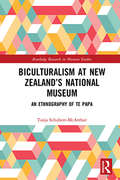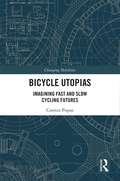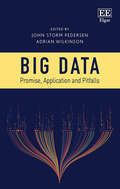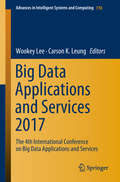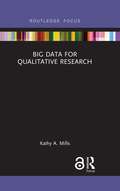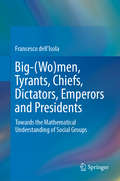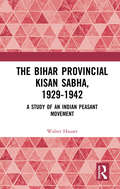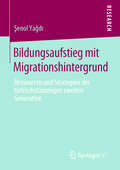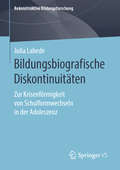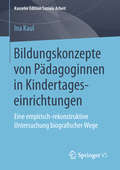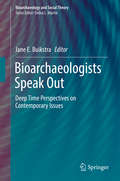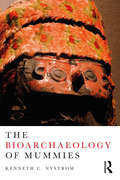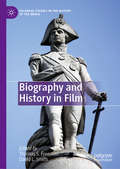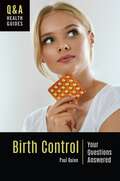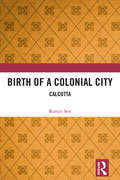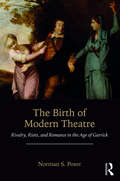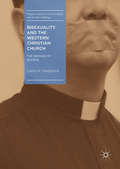- Table View
- List View
Biculturalism at New Zealand’s National Museum: An Ethnography of Te Papa (Routledge Research in Museum Studies)
by Tanja Schubert-McArthurThe Museum of New Zealand Te Papa Tongarewa has been celebrated as an international leader for its bicultural concept and partnership with Māori in all aspects of the museum, but how does this relationship with the indigenous partner work in practice? Biculturalism at New Zealand’s National Museum reveals the challenges, benefits and politics of implementing a bicultural framework in everyday museum practice. Providing an analysis of the voices of museum employees, the book reflects their multifaceted understandings of biculturalism and collaboration. Based on a year of intensive fieldwork behind the scenes at New Zealand’s national museum and drawing on 68 interviews and participant observations with 18 different teams across the organisation, this book examines the interactions and cultural clashes between Māori and non-Māori museum professionals in their day-to-day work. Documenting and analysing contemporary museum practices, this account explores how biculturalism is enacted, negotiated, practised and envisioned on different stages within the complex social institution that is the museum. Lessons learnt from Te Papa will be valuable for other museums, NGOs, the public service and organisations facing similar issues around the world. Biculturalism at New Zealand’s National Museum addresses a gap in the literature on biculturalism and reaffirms the importance of ethnography to the anthropological enterprise and museum studies research. As such, it will be essential reading for academics, researchers and postgraduate students in the fields of cultural anthropology, museum anthropology, museum studies, and Māori studies or indigenous studies. It should also be of great interest to museum professionals.
Bicycle Utopias: Imagining Fast and Slow Cycling Futures (Changing Mobilities)
by Cosmin PopanBicycle Utopias investigates the future of urban mobilities and post-car societies, arguing that the bicycle can become the nexus around which most human movement will revolve. Drawing on literature on post-car futures (Urry 2007; Dennis and Urry 2009), transition theory (Geels et al. 2012) and utopian studies (Levitas 2010, 2013), this book imagines a slow bicycle system as a necessary means to achieving more sustainable mobility futures. The imagination of a slow bicycle system is done in three ways: Scenario building to anticipate how cycling mobilities will look in the year 2050. A critique of the system of automobility and of fast cycling futures. An investigation of the cycling senses and sociabilities to describe the type of societies that such a slow bicycle system will enable. Bicycle Utopias will appeal to students and scholars in fields such as sociology, mobilities studies, human geography and urban and transport studies. This work may also be of interest to advocates, activists and professionals in the domains of cycling and sustainable mobilities.
Bicycle Utopias: Imagining Fast and Slow Cycling Futures (Changing Mobilities)
by Cosmin PopanBicycle Utopias investigates the future of urban mobilities and post-car societies, arguing that the bicycle can become the nexus around which most human movement will revolve. Drawing on literature on post-car futures (Urry 2007; Dennis and Urry 2009), transition theory (Geels et al. 2012) and utopian studies (Levitas 2010, 2013), this book imagines a slow bicycle system as a necessary means to achieving more sustainable mobility futures. The imagination of a slow bicycle system is done in three ways: Scenario building to anticipate how cycling mobilities will look in the year 2050. A critique of the system of automobility and of fast cycling futures. An investigation of the cycling senses and sociabilities to describe the type of societies that such a slow bicycle system will enable. Bicycle Utopias will appeal to students and scholars in fields such as sociology, mobilities studies, human geography and urban and transport studies. This work may also be of interest to advocates, activists and professionals in the domains of cycling and sustainable mobilities.
Big Data: Promise, Application and Pitfalls
by Adrian Wilkinson John S. PedersenSince the early 2000s, digital data has transformed the way we live and work. This timely book looks to big data analytics to understand this revolutionary change, unpacking the impact of big data analytics on the mobilization and allocation of individuals, organizations and societies’ resources. Contributions from leading experts on modern technological trends examine the promises, applications and pitfalls of big data. The contributors assess the ways in which contemporary trajectories of data processing have increased efficiency and had a transformative effect on all avenues of life, from energy, tourism and social media, to human resources, welfare systems and urban citizenship. At a time when our personal data is more valuable than ever, this book seeks to make sense of how big data analytics has transformed our lives and how it will continue to shape society in the future. Astute and comprehensive, this book is critical reading for business and management scholars with a focus on information systems and communications technologies. It will also prove to be vital information for students and researchers of big data and digital society, as well as politics and administration more widely.
Big Data Applications and Services 2017: The 4th International Conference on Big Data Applications and Services (Advances in Intelligent Systems and Computing #770)
by Wookey Lee Carson K. LeungThis proceedings volume contains selected papers from the Fourth International Conference on Big Data Applications and Services (BigDAS 2017), held in Tashkent, Uzbekistan on August 15-18, 2017. Big data has become a core technology providing innovative solutions in many fields including social media, healthcare and manufacturing. The Fourth International Conference on Big Data Applications and Services (BigDAS 2017) presented innovative results, encouraged academic and industrial interaction, and promoted collaborative research in the field of big data worldwide. The conference was organized by the Korea Big Data Services Society and National University of Uzbekistan.
Big Data for Qualitative Research
by Kathy A. MillsBig Data for Qualitative Research covers everything small data researchers need to know about big data, from the potentials of big data analytics to its methodological and ethical challenges. The data that we generate in everyday life is now digitally mediated, stored, and analyzed by web sites, companies, institutions, and governments. Big data is large volume, rapidly generated, digitally encoded information that is often related to other networked data, and can provide valuable evidence for study of phenomena. This book explores the potentials of qualitative methods and analysis for big data, including text mining, sentiment analysis, information and data visualization, netnography, follow-the-thing methods, mobile research methods, multimodal analysis, and rhythmanalysis. It debates new concerns about ethics, privacy, and dataveillance for big data qualitative researchers. This book is essential reading for those who do qualitative and mixed methods research, and are curious, excited, or even skeptical about big data and what it means for future research. Now is the time for researchers to understand, debate, and envisage the new possibilities and challenges of the rapidly developing and dynamic field of big data from the vantage point of the qualitative researcher.
Big Data for Qualitative Research
by Kathy A. MillsBig Data for Qualitative Research covers everything small data researchers need to know about big data, from the potentials of big data analytics to its methodological and ethical challenges. The data that we generate in everyday life is now digitally mediated, stored, and analyzed by web sites, companies, institutions, and governments. Big data is large volume, rapidly generated, digitally encoded information that is often related to other networked data, and can provide valuable evidence for study of phenomena. This book explores the potentials of qualitative methods and analysis for big data, including text mining, sentiment analysis, information and data visualization, netnography, follow-the-thing methods, mobile research methods, multimodal analysis, and rhythmanalysis. It debates new concerns about ethics, privacy, and dataveillance for big data qualitative researchers. This book is essential reading for those who do qualitative and mixed methods research, and are curious, excited, or even skeptical about big data and what it means for future research. Now is the time for researchers to understand, debate, and envisage the new possibilities and challenges of the rapidly developing and dynamic field of big data from the vantage point of the qualitative researcher.
Big-(Wo)men, Tyrants, Chiefs, Dictators, Emperors and Presidents: Towards the Mathematical Understanding of Social Groups
by Francesco dell'IsolaThis book highlights mathematical ideas to help explain a number of important aspects of the dynamics of social groups. These ideas are similar to those used to describe the behaviour of Lagrangian mechanical systems, and as such this book appeals to anyone wanting to gain an understanding of the intrinsic unity of natural phenomena.
The Bihar Provincial Kisan Sabha, 1929-1942: A Study of an Indian Peasant Movement
by Walter HauserOn December 5th, 1920, in Patna, the Dasnami sannyasi Sahajanand Saraswati encountered Mahatma Gandhi for the first time. Sahajanand was already known in social-reform circles in Bihar as an energetic activist and educator working to promote Bhumihar Brahman identity. Inspired by the Mahatma’s radical reformulation of Indian nationalism, ‘the Swami’ (as Sahajanand would soon come to be known) threw himself into nationalist politics and the Indian National Congress. Within a decade, moved by the plight of tenant-farmers struggling against excessive rent demands and abusive landlord ‘exactions’, the Swami had spearheaded the formation of the Bihar Provincial Kisan Sabha. This organization quickly became the largest organization of its kind in India, catapulting the Swami onto the national stage. By the early mid-1930s the Swami had publicly broken with both the Mahatma and the ‘Gandhians’ and had made common cause with the left wing of the Congress. Later, as the storm clouds of World War II gathered on the horizon, he joined forces with the Forward Bloc and the Communist Party of India. By the time of his death in 1950, the Swami, disillusioned with politics, had dissociated himself from all parties.This pioneering 1961 study by Walter Hauser, tracks the history of the Bihar peasant movement as it both influenced and was buffeted by national and international politics. Hauser offers here a penetrating analysis of the character of the movement and the mind of its leader as he grappled with and gravitated toward Marxism-Leninism in the 1930s and 1940s. Initially written as a Ph.D. dissertation at the University of Chicago, Hauser’s path-breaking Bihar Provincial Kisan Sabha, 1929-1942 is now being published in its entirety for the first time. The volume includes a ‘Foreword’ by one of Hauser’s many students, William R. Pinch. Please note: Taylor & Francis does not sell or distribute the Hardback in India, Pakistan, Nepal, Bhutan, Bangladesh and Sri Lanka
The Bihar Provincial Kisan Sabha, 1929-1942: A Study of an Indian Peasant Movement
by Walter HauserOn December 5th, 1920, in Patna, the Dasnami sannyasi Sahajanand Saraswati encountered Mahatma Gandhi for the first time. Sahajanand was already known in social-reform circles in Bihar as an energetic activist and educator working to promote Bhumihar Brahman identity. Inspired by the Mahatma’s radical reformulation of Indian nationalism, ‘the Swami’ (as Sahajanand would soon come to be known) threw himself into nationalist politics and the Indian National Congress. Within a decade, moved by the plight of tenant-farmers struggling against excessive rent demands and abusive landlord ‘exactions’, the Swami had spearheaded the formation of the Bihar Provincial Kisan Sabha. This organization quickly became the largest organization of its kind in India, catapulting the Swami onto the national stage. By the early mid-1930s the Swami had publicly broken with both the Mahatma and the ‘Gandhians’ and had made common cause with the left wing of the Congress. Later, as the storm clouds of World War II gathered on the horizon, he joined forces with the Forward Bloc and the Communist Party of India. By the time of his death in 1950, the Swami, disillusioned with politics, had dissociated himself from all parties.This pioneering 1961 study by Walter Hauser, tracks the history of the Bihar peasant movement as it both influenced and was buffeted by national and international politics. Hauser offers here a penetrating analysis of the character of the movement and the mind of its leader as he grappled with and gravitated toward Marxism-Leninism in the 1930s and 1940s. Initially written as a Ph.D. dissertation at the University of Chicago, Hauser’s path-breaking Bihar Provincial Kisan Sabha, 1929-1942 is now being published in its entirety for the first time. The volume includes a ‘Foreword’ by one of Hauser’s many students, William R. Pinch. Please note: Taylor & Francis does not sell or distribute the Hardback in India, Pakistan, Nepal, Bhutan, Bangladesh and Sri Lanka
Bildungsaufstieg mit Migrationshintergrund: Ressourcen und Strategien der türkischstämmigen zweiten Generation
by Şenol YaĝdıŞenol Yaĝdı analysiert den Bildungsaufstieg von türkischstämmigen Studierenden der zweiten Generation in Österreich anhand leitfadengestützter Interviews. Aus einer bildungssoziologischen Perspektive werden die unterschiedlichen Einflussfaktoren, Ressourcen, Herausforderungen und Probleme der Zielgruppe auf ihrem Bildungsweg erforscht, um die Gelingensbedingungen für den Bildungsaufstieg und ihre damit verbundenen Handlungsstrategien zu ergründen. Der Autor verweist auf die Relevanz eines migrationsspezifischen kulturellen Kapitals als Möglichkeit der Habitustransformation im Rahmen einer intergenerationellen Transmission von Bildungsaufträgen.
Bildungsbiografische Diskontinuitäten: Zur Krisenförmigkeit von Schulformwechseln in der Adoleszenz (Rekonstruktive Bildungsforschung #26)
by Julia LabedeWie Schulformwechsel in der Familie verhandelt werden und wie diese Verhandlung eine Dynamik befördert, die nach einem „Ab-“ oder „Umstieg“ im Bildungssystem einen „‚Aufstieg“ ermöglicht, untersucht diese Studie fallrekonstruktiv. Anhand zweier Fallstudien werden familiale Idealisierungen und Krisengeschichten sowie ein verstärkter Selbstbezug in der Adoleszenz als Beitrag für die Genese von Wehrhaftigkeit gegenüber problematischen schulischen Adressierungen herausgearbeitet. Die Krisenhaftigkeit eines Schulformwechsels wird dabei auf eine narzisstische Kränkung zurückgeführt und im Spannungsfeld von Ideal- und Realselbst verortet.
Bildungskonzepte von Pädagoginnen in Kindertageseinrichtungen
by Ina KaulIna Kaul untersucht die Entstehung und Entwicklung von Bildungskonzepten von Pädagoginnen im Handlungsfeld der Kindertageseinrichtung. Sie zeigt, wie sich eine Vorstellung von dem, was die Pädagoginnen unter Bildung verstehen, über biografische Erfahrungen und im Kontext der Frage nach dem gesellschaftlichen Auftrag herausbildet, welche Bezugspunkte die Pädagoginnen als Referenzrahmen heranziehen und wie sie sich in diesem Kontext positionieren und Bildung in der frühen Kindheit thematisieren. Damit greift die Autorin im Kontext des Professionalisierungsprozesses die Frage nach der Verschränkung von Biografie und Wissen auf und plädiert unter anderem für die Bedeutung von Reflexivität.
Bioarchaeologists Speak Out: Deep Time Perspectives on Contemporary Issues (Bioarchaeology and Social Theory)
by Jane E. BuikstraBioarchaeologists who study human remains in ancient, historic and contemporary settings are securely anchored within anthropology as anthropologists, yet they have not taken on the pundits the way other subdisciplines within anthropology have. Popular science authors frequently and selectively use bioarchaeological data on demography, disease, violence, migration and diet to buttress their poorly formed arguments about general trends in human behavior and health, beginning with our earliest ancestors. While bioarchaeologists are experts on these subjects, bioarchaeology and bioarchaeological approaches have largely remained invisible to the public eye. Current issues such as climate change, droughts, warfare, violence, famine, and the effects of disease are media mainstays and are subjects familiar to bioarchaeologists, many of whom have empirical data and informed viewpoints, both for topical exploration and also for predictions based on human behavior in deep time. The contributions in this volume will explore the how and where the data has been misused, present new ways of using evidence in the service of making new discoveries, and demonstrate ways that our long term interdisciplinarity lends itself to transdisciplinary wisdom. We also consider possible reasons for bioarchaeological invisibility and offer advice concerning the absolute necessity of bioarchaeologists speaking out through social media.
The Bioarchaeology of Mummies
by Kenneth C. NystromThe modern manifestation of mummy studies began to take shape in the 1970s and has experienced significant growth during the last several decades, largely due to biomedical interest in soft tissue pathology. Although this points to a vibrant field, there are indications that we need to take stock of where it is today and how it may develop in the future, and this volume responds to those demands. In many ways, mummy studies and skeletal bioarchaeology are "sister-disciplines," sharing data sources, methodologies, and practitioners. Given these close connections, this book considers whether paradigmatic shifts that influenced the development of the latter also impacted the former. Whilst there are many available books discussing mummy research, most recent field-wide reviews adopt a biomedical perspective to explore a particular mummy or collection of mummies. The Bioarchaeology of Mummies is a unique attempt at a synthetic, state-of-the-field critical analysis which considers the field from an explicitly anthropological perspective. This book is written for both skeletal bioarcheologists that may not be familiar with the scope of mummy research, and mummy researchers from biomedical fields that may not be as acquainted with current research trends within bioarchaeology.
The Bioarchaeology of Mummies
by Kenneth C. NystromThe modern manifestation of mummy studies began to take shape in the 1970s and has experienced significant growth during the last several decades, largely due to biomedical interest in soft tissue pathology. Although this points to a vibrant field, there are indications that we need to take stock of where it is today and how it may develop in the future, and this volume responds to those demands. In many ways, mummy studies and skeletal bioarchaeology are "sister-disciplines," sharing data sources, methodologies, and practitioners. Given these close connections, this book considers whether paradigmatic shifts that influenced the development of the latter also impacted the former. Whilst there are many available books discussing mummy research, most recent field-wide reviews adopt a biomedical perspective to explore a particular mummy or collection of mummies. The Bioarchaeology of Mummies is a unique attempt at a synthetic, state-of-the-field critical analysis which considers the field from an explicitly anthropological perspective. This book is written for both skeletal bioarcheologists that may not be familiar with the scope of mummy research, and mummy researchers from biomedical fields that may not be as acquainted with current research trends within bioarchaeology.
Biography and History in Film (Palgrave Studies in the History of the Media)
by Thomas S. Freeman David L. SmithThe essays in this volume seek to analyze biographical films as representations of historical individuals and the times in which they lived. To do this, contributors examine the context in which certain biographical films were made, including the state of knowledge about their subjects at that moment, and what these films reveal about the values and purposes of those who created them. This is an original approach to biographical (as opposed to historical) films and one that has so far played little part in the growing literature on historical films. The films discussed here date from the 1920s to the 2010s, and deal with males and females in periods ranging from the Middle Ages to the end of the twentieth century. In the process, the book discusses how biographical films reflect changing attitudes towards issues such as race, gender and sexuality, and examines the influence of these films on popular perceptions of the past. The introduction analyses the nature of biographical films as a genre: it compares and contrasts the nature of biography on film with written biographies, and considers their relationship with the discipline of history. As the first collection of essays on this popular but understudied genre, this book will be of interest to historians as well as those in film and cultural studies.
Birth Control: Your Questions Answered (Q&A Health Guides)
by Paul QuinnThis book will serve as a scientifically accurate yet easy-to-read introduction to birth control for teens and young adults. The information, guidance, and resources it offers will help readers to make better decisions regarding their sexual health.From barrier methods such as condoms and diaphragms to oral contraceptive pills and from hormone-based implants and injectables to permanent sterilization techniques, there are a number of ways to prevent unwanted pregnancy today. But which are the most effective, and how do you choose the method that's right for you? What about side effects and long-term implications for health, such as increased risk for cancer? Does birth control affect your chances of getting pregnant in the future? Birth Control: Your Questions Answered, a part of Greenwood's Q&A Health Guides series, provides clear, concise answers to these and other questions young readers may have about this sometimes embarrassing, yet very important, topic. Each book in this series follows a reader-friendly question-and-answer format that anticipates readers' needs and concerns. Prevalent myths and misconceptions are identified and dispelled, and a collection of case studies illustrates key concepts and issues through relatable stories and insightful recommendations. The book also includes a section on health literacy, equipping teens and young adults with practical tools and strategies for finding, evaluating, and using credible sources of health information both on and off the internet—important skills that contribute to a lifetime of healthy decision-making.
Birth Control: Your Questions Answered (Q&A Health Guides)
by Paul QuinnThis book will serve as a scientifically accurate yet easy-to-read introduction to birth control for teens and young adults. The information, guidance, and resources it offers will help readers to make better decisions regarding their sexual health.From barrier methods such as condoms and diaphragms to oral contraceptive pills and from hormone-based implants and injectables to permanent sterilization techniques, there are a number of ways to prevent unwanted pregnancy today. But which are the most effective, and how do you choose the method that's right for you? What about side effects and long-term implications for health, such as increased risk for cancer? Does birth control affect your chances of getting pregnant in the future? Birth Control: Your Questions Answered, a part of Greenwood's Q&A Health Guides series, provides clear, concise answers to these and other questions young readers may have about this sometimes embarrassing, yet very important, topic. Each book in this series follows a reader-friendly question-and-answer format that anticipates readers' needs and concerns. Prevalent myths and misconceptions are identified and dispelled, and a collection of case studies illustrates key concepts and issues through relatable stories and insightful recommendations. The book also includes a section on health literacy, equipping teens and young adults with practical tools and strategies for finding, evaluating, and using credible sources of health information both on and off the internet—important skills that contribute to a lifetime of healthy decision-making.
Birth of a Colonial City: Calcutta
by Ranjit SenLong before Calcutta was ‘discovered’ by Job Charnock, it thrived by the Hugli since times immemorial. This book, and its companion Colonial Calcutta, is a biographical account of the when, the how and the what of a global city and its emergence under colonial rule in the 1800s. Ranjit Sen traces the story of how three clustered villages became the hub of the British Empire and a centre of colonial imagination. He examines the historical and geopolitical factors that were significant in securing its prominence, and its subsequent urbanization which was a colonial experience without an antecedent. Further, it sheds light on Calcutta’s early search for identity — how it superseded interior towns and flourished as the seat of power for its hinterland; developed its early institutions, while its municipal administration slowly burgeoned. A sharp analysis of the colonial enterprise, this volume lays bare the underbelly of the British Raj. It will be of great interest to scholars and researchers of modern history, South Asian history, urban studies, British Studies and area studies.
Birth of a Colonial City: Calcutta
by Ranjit SenLong before Calcutta was ‘discovered’ by Job Charnock, it thrived by the Hugli since times immemorial. This book, and its companion Colonial Calcutta, is a biographical account of the when, the how and the what of a global city and its emergence under colonial rule in the 1800s. Ranjit Sen traces the story of how three clustered villages became the hub of the British Empire and a centre of colonial imagination. He examines the historical and geopolitical factors that were significant in securing its prominence, and its subsequent urbanization which was a colonial experience without an antecedent. Further, it sheds light on Calcutta’s early search for identity — how it superseded interior towns and flourished as the seat of power for its hinterland; developed its early institutions, while its municipal administration slowly burgeoned. A sharp analysis of the colonial enterprise, this volume lays bare the underbelly of the British Raj. It will be of great interest to scholars and researchers of modern history, South Asian history, urban studies, British Studies and area studies.
The Birth of Modern Theatre: Rivalry, Riots, and Romance in the Age of Garrick
by Norman S. PoserThe Birth of Modern Theatre: Rivalry, Riots, and Romance in the Age of Garrick is a vivid description of the eighteenth-century London theatre scene—a time when the theatre took on many of the features of our modern stage. A natural and psychologically based acting style replaced the declamatory style of an earlier age. The theatres were mainly supported by paying audiences, no longer by royal or noble patrons. The press determined the success or failure of a play or a performance. Actors were no longer shunned by polite society, some becoming celebrities in the modern sense. The dominant figure for thirty years was David Garrick, actor, theatre manager and playwright, who, off the stage, charmed London with his energy, playfulness, and social graces. No less important in defining eighteenth-century theatre were its audiences, who considered themselves full-scale participants in theatrical performances; if they did not care for a play, an actor, or ticket prices, they would loudly make their wishes known, sometimes starting a riot. This book recounts the lives—and occasionally the scandals—of the actors and theatre managers and weaves them into the larger story of the theatre in this exuberant age, setting the London stage and its leading personalities against the background of the important social, cultural, and economic changes that shaped eighteenth-century Britain. The Birth of Modern Theatre brings all of this together to describe a moment in history that sowed the seeds of today’s stage.
The Birth of Modern Theatre: Rivalry, Riots, and Romance in the Age of Garrick
by Norman S. PoserThe Birth of Modern Theatre: Rivalry, Riots, and Romance in the Age of Garrick is a vivid description of the eighteenth-century London theatre scene—a time when the theatre took on many of the features of our modern stage. A natural and psychologically based acting style replaced the declamatory style of an earlier age. The theatres were mainly supported by paying audiences, no longer by royal or noble patrons. The press determined the success or failure of a play or a performance. Actors were no longer shunned by polite society, some becoming celebrities in the modern sense. The dominant figure for thirty years was David Garrick, actor, theatre manager and playwright, who, off the stage, charmed London with his energy, playfulness, and social graces. No less important in defining eighteenth-century theatre were its audiences, who considered themselves full-scale participants in theatrical performances; if they did not care for a play, an actor, or ticket prices, they would loudly make their wishes known, sometimes starting a riot. This book recounts the lives—and occasionally the scandals—of the actors and theatre managers and weaves them into the larger story of the theatre in this exuberant age, setting the London stage and its leading personalities against the background of the important social, cultural, and economic changes that shaped eighteenth-century Britain. The Birth of Modern Theatre brings all of this together to describe a moment in history that sowed the seeds of today’s stage.
Bisexuality and the Western Christian Church: The Damage of Silence (Palgrave Studies in Lived Religion and Societal Challenges)
by Carol A. ShepherdThis book critically examines the lived experiences of bisexual Christians across a range of Christian traditions in the UK and the USA. Shepherd assesses whether current data on elevated rates of depressive illnesses among bisexual people also apply to the bisexual Christian community. Drawing on data collected by the author on bisexual Christians across the lifespan, the book uncovers shocking incidences of biphobia and bi erasure in the Church. Widespread ignorance among pastors of middle sexualities outside of the hetero-/homonormative binary is revealed as well as a corresponding absence of appropriate support resources. Bisexuality and the Western Christian Church will be of interest to students and scholars across a range of disciplines, including gender studies, applied theology, sociology and social psychology. It is also important reading for clergy, and LGBT faith organisations. With a Foreword by Eric Anderson, Professor of Sport, Masculinities, and Sexualities, University of Winchester, UK.
Bisexuality and the Western Christian Church: The Damage of Silence (Palgrave Studies in Lived Religion and Societal Challenges)
by Carol A. ShepherdThis book critically examines the lived experiences of bisexual Christians across a range of Christian traditions in the UK and the USA. Shepherd assesses whether current data on elevated rates of depressive illnesses among bisexual people also apply to the bisexual Christian community. Drawing on data collected by the author on bisexual Christians across the lifespan, the book uncovers shocking incidences of biphobia and bi erasure in the Church. Widespread ignorance among pastors of middle sexualities outside of the hetero-/homonormative binary is revealed as well as a corresponding absence of appropriate support resources. Bisexuality and the Western Christian Church will be of interest to students and scholars across a range of disciplines, including gender studies, applied theology, sociology and social psychology. It is also important reading for clergy, and LGBT faith organisations. With a Foreword by Eric Anderson, Professor of Sport, Masculinities, and Sexualities, University of Winchester, UK.
